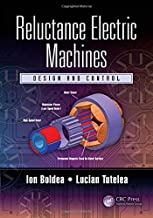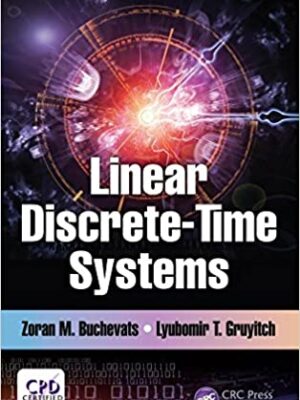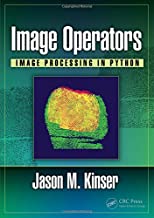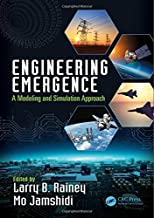Reluctance Electric Machines: Design & Control
Original price was: ₹15,078.00.₹12,062.40Current price is: ₹12,062.40.
ISBN: 9781498782333
Author/Editor: Ion Boldea
Publisher: CRC Press
Year: 2019
1 in stock (can be backordered)
Description
Electric energy is arguably a key agent for our material prosperity. With the notable exception of photovoltaic generators, electric generators are exclusively used to produce electric energy from mechanical energy. More than 60% of all electric energy is used in electric motors for useful mechanical work in various industries. This book presents the modeling, performance, design, and control of reluctance synchronous and flux-modulation machines developed for higher efficiency and lower cost. It covers one- and three-phase reluctance synchronous motors in line-start applications and various reluctance flux-modulation motors in pulse width modulation converter-fed variable speed drives.
FEATURES
Presents basic and up-to-date knowledge about the topologies, modeling, performance, design, and control of reluctance synchronous machines.
Includes information on recently introduced reluctance flux-modulation electric machines (switched- flux, flux-reversal, Vernier, transverse flux, claw pole, magnetic-geared dual-rotor, brushless doubly fed, etc.).
Features numerous examples and case studies throughout.
Provides a comprehensive overview of all reluctance electric machines.
Additional information
| Weight | 0.191 kg |
|---|
Product Properties
| Year of Publication | 2019 |
|---|---|
| Table of Contents | Chapter 1 Reluctance Electric Machines: An Introduction 1.1 Electric Machines: Why and Where? 1.2 Electric Machine (and Drive) Principles and Topologies 1.3 Reluctance Electric Machine Principles 1.4 Reluctance Electric Machine Classifications 1.5 Flux-Modulation Reluctance Electric Machines 1.6 Summary References Chapter 2 Line-Start Three-Phase Reluctance Synchronous Machines: Modeling, Performance, and Design 2.1 Introduction 2.2 Three-Phase Line-Start Reluctance Synchronous Machines: Topologies, Field Distribution, and Circuit Parameters 2.3 Synchronous Steady State by the Circuit Model 2.4 Asynchronous Torque Components 2.5 Electromagnetic Design Issues 2.6 Testing for Performance and Parameters 2.7 Summary References Chapter 3 Phase-Source Line-Start Cage Rotor Permanent Magnet-Reluctance Synchronous Machines: Modeling, Performance and Design 3.1 Introduction 3.2 Equivalent Magnetic Circuit Model for Saturated Magnetization Inductances Ldm, Lqm 3.3 The Electric Circuit Model 3.4 Asynchronous Mode Circuit Model 3.5 Permanent Magnet Average Braking Torque 3.6 Steady State Synchronous Performance/Sample Results 3.7 The dq Model for Transients 3.8 Optimal Design Methodology by a Case Study 3.9 Finite-Element Modeling Validation 3.10 Parameter Estimation and Segregation of Losses in Single-Phase Capacitor Permanent Magnet-Reluctance Synchronous Machines by Tests 3.11 Summary References Chapter 4 Three-Phase Variable-Speed Reluctance Synchronous Motors: Modeling, Performance, and Design 4.1 Introduction 4.2 Analytical Field Distribution and Ldm(Id), Lqm(Iq) Inductance Calculation 4.3 The Axially Laminated Anisotropic-Rotor 4.4 Tooth-Wound Coil Windings in Reluctance Synchronous Motors 4.5 Finite-Element Approach to Field Distribution, Torque, Inductances, and Core Losses 4.6 The Circuit dq (Space Phasor) Model and Steady State Performance 4.7 Design Methodologies by Case Studies 4.8 Multipolar Ferrite-Permanent Magnet Reluctance Synchronous Machine Design 4.9 Improving Power Factor and Constant Power Speed Range by Permanent Magnet Assistance in Reluctance Synchronous Machines 4.10 Reluctance Synchronous Machine and Permanent Magnet-Reluctance Synchronous Machine Optimal Design Based on Finite-Element Method Only 4.11 Summary References Chapter 5 Control of Three-Phase Reluctance Synchronous Machine and Permanent Magnet-Reluctance Synchronous Machine Drives 5.1 Introduction 5.2 Performance Indexes of Variable-Speed Drives 5.3 Reluctance Synchronous Machine and Permanent Magnet-Reluctance Synchronous Machine Control Principles 5.4 Field-Oriented Control Principles 5.5 Direct Torque and Flux Control 5.6 Field-Oriented Control and Direct Torque and Flux Control of Permanent Magnet-Reluctance Synchronous Machines for Wide Constant Power Speed Range 5.7 Encoderless Field-Oriented Control of Reluctance Synchronous Machines 5.8 Active Flux-Based Model Encoderless Control of Reluctance Synchronous Machines 5.9 A Wide Speed Range Encoderless Control of Permanent Magnet-Reluctance Synchronous Machines 5.10 V/F with Stabilizing Loop Control of Permanent Magnet-Reluctance Synchronous Machine 5.11 Summary References Chapter 6 Claw Pole and Homopolar Synchronous Motors: Modeling, Design, and Control 6.1 Introduction 6.2 Claw Pole-Synchronous Motors: Principles and Topologies 6.3 Claw Pole-Synchronous Motors Modeling 6.4 Claw Pole-Synchronous Motors: The dq Circuit Model for Steady State and Transients 6.5 Optimal Design of Claw Pole-Synchronous Motors 6.6 Optimal Design of a Permanent Magnet-Excited Claw Pole-Synchronous Motor: A Case Study 6.7 Claw Pole-Synchronous Motor Large Power Design Example 6.2 (3 MW, 75 rpm) 6.8 Control of Claw Pole-Synchronous Motors for Variable Speed Drives 6.9 The Homopolar-Synchronous Motor 6.10 Summary References Chapter 7 Brushless Direct Current-Multiple Phase Reluctance Motor Modeling, Control, and Design 7.1 Introduction 7.2 Torque Density and Loss Comparisons with Induction Motors 7.3 Control Principles 7.4 Finite-Element Model-Based Characterization versus Tests via a Case Study 7.5 Nonlinear Magnetic Equivalent Circuit Modeling by a Case Study 7.6 Circuit Model and Control 7.7 Optimal Design Methodology and Code with a Case Study 7.8 Summary References Chapter 8 Brushless Doubly-Fed Reluctance Machine Drives 8.1 Introduction 8.2 Phase Coordinate and dq Model 8.3 Magnetic Equivalent Circuit Modeling with Finite-Element Model Validation 8.4 Control of Brushless Doubly-Fed Reluctance Machines 8.5 Practical Design Issues 8.6 Summary References Chapter 9 Switched Flux-Permanent Magnet Synchronous Motor Analysis, Design, and Control 9.1 Introduction 9.2 The Nature of Switched Flux-Permanent Magnet Synchronous Motors 9.3 A Comparison between Switched Flux-Permanent Magnet Synchronous Motors and Interior Permanent Magnet Synchronous Motors 9.4 E-Core Hybrid Excited Switched Flux-Permanent Magnet Synchronous Motors 9.5 Switched Flux-Permanent Magnet Synchronous Motors with Memory AlNiCo Assistance for Variable Flux 9.6 Partitioned Stator Switched Flux-Permanent Magnet Synchronous Motors 9.7 Circuit dq Model and Control of Switched Flux-Permanent Magnet Synchronous Motors 9.8 Summary References Chapter 10 Flux-Reversal Permanent Magnet Synchronous Machines 10.1 Introduction 10.2 Technical Theory via Preliminary Design Case Study 10.3 Finite-Element Model Geometry 10.4 Comparison between Flux-Reversal Permanent Magnet Synchronous Machines and Surface Permanent Magnet Synchronous Motor 10.5 Three Phase Flux-Reversal Permanent Magnet Synchronous Machines with Rotor Permanent Magnets 10.6 One-Phase Flux-Reversal Permanent Magnet Synchronous Machine 10.7 Summary References Chapter 11 Vernier PM Machines 11.1 Introduction 11.2 Preliminary Design Methodology through Case Study 11.3 Hard-Learned Lessons from Finite-Element Method Analysis of Vernier Permanent Magnet Machines 11.4 Vernier Permanent Magnet Machine Control Issues 11.5 Vernier Permanent Magnet Machine Optimal Design Issues 11.6 Combined Vernier and Flux-Reversal Permanent Magnet Machines 11.7 Summary References Chapter 12 Transverse Flux Permanent Magnet Synchronous Motor Analysis, Optimal Design, and Control 12.1 Introduction 12.2 Preliminary Nonlinear Analytical Design Methodology 12.3 Magnetic Equivalent Circuit Method Modeling 12.4 Optimal Design via a Case Study 12.5 Finite-Element Model Characterization of Transverse Flux Permanent Magnet Synchronous Motors 12.6 Control Issues 12.7 Summary References Chapter 13 Magnetic-Geared Dual-Rotor Reluctance Electric Machines: Topologies, Analysis, Performance 13.1 Introduction 13.2 Dual-Rotor Interior Stator Magnetic-Geared Reluctance Electric Machines 13.3 Brushless Dual-Rotor Dual-Electric Part Magnetic-Geared Reluctance Electric Machines 13.4 Summary References Chapter 14 Direct Current + Alternating Current Stator Doubly Salient Electric Machines: Analysis, Design, and Performance 14.1 Introduction 14.2 Two-Slot-Span Coil Stator Direct Current + Alternating Current Winding Doubly Salient Machines 14.3 12/10 Direct Current + Alternating Current Double Salient Machine with Tooth-Wound Direct Current and Alternating Current Coils on Stator 14.4 The Direct Current + Alternating Current Stator Switched Reluctance Machine 14.5 Summary References |
| Author | Ion Boldea |
| ISBN/ISSN | 9781498782333 |
| Binding | Hardback |
| Edition | 1 |
| Publisher | CRC Press |
You must be logged in to post a review.






Reviews
There are no reviews yet.